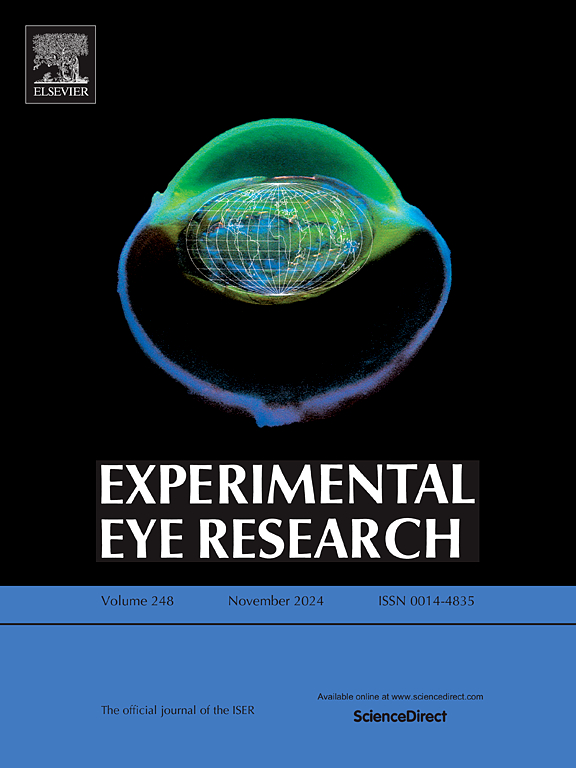Egr1/Gc/vitamin transport axis mediates synergistic effect of macular thinning and underweight in age-related visual acuity decline
IF 3
2区 医学
Q1 OPHTHALMOLOGY
引用次数: 0
Abstract
To investigate the associated risk factors and potential molecular mechanisms affecting visual acuity (VA) in the elderly, this cross-sectional, population-based study collected the general information, past medical history and ophthalmologic data of 841 Shanghai elderly residents (mean age 69.61 ± 5.70 years, range 52–92 years). Univariate and multivariate logistic regression analyses revealed that the presenting worse VA problem was significantly associated with being underweight (OR = 3.071, P = 0.002). Across nine distinct macular retinal regions, thinning within 0.5–3.0 mm of the fovea (excluding the superior inner retina) was significantly associated with worse VA (all P < 0.05). Mouse models demonstrated that, compared to the simple retinal thinning group, the retinal thinning combined with underweight group exhibited more severe structural damage and elevated cell apoptosis rates via hematoxylin and eosin (HE) and terminal deoxynucleotidyl transferase dUTP nick-end labeling (TUNEL) staining. Electroretinogram showed that combined retinal thinning and underweight synergistically exacerbated visual dysfunction. To further explore the molecular mechanism underlying the retinal thinning-underweight phenotype, bulk RNA-seq analysis revealed a significant downregulation of vitamin D-binding protein (Gc), which was positively regulated by the transcription factor, early growth response 1 (Egr1). Pathway analysis highlighted the involvement of vitamin transmembrane transporter activity. Consistent with bioinformatics predictions, Western blot confirmed a significant downregulation of both Gc and Egr1 in the retinal thinning-underweight group. Collectively, we identified underweight and retinal thinning as systemic and ocular risk factors for worse VA in the elderly. Their synergistic effect deteriorated VA through the Egr1/Gc/vitamin transport axis.
Egr1/Gc/维生素运输轴介导黄斑变薄和体重不足在老年性视力下降中的协同作用
为探讨影响老年人视力的相关危险因素及可能的分子机制,本研究收集了841名上海市老年人(平均年龄69.61±5.70岁,年龄范围52 ~ 92岁)的一般资料、既往病史和眼科资料。单因素和多因素logistic回归分析显示,表现较差的VA问题与体重过轻显著相关(OR = 3.071, P = 0.002)。在九个不同的黄斑视网膜区域,中央凹0.5-3.0 mm范围内变薄(不包括上内视网膜)与VA恶化显著相关(所有P <;0.05)。小鼠模型通过苏木精伊红(HE)和末端脱氧核苷酸转移酶dUTP镍端标记(TUNEL)染色显示,与单纯视网膜变薄组相比,视网膜变薄合并体重过轻组表现出更严重的结构损伤和细胞凋亡率升高。视网膜电图显示视网膜变薄和体重过轻共同加重了视力障碍。为了进一步探索视网膜变薄-体重过轻表型的分子机制,大量RNA-seq分析显示,维生素d结合蛋白(Gc)显著下调,并受到转录因子早期生长反应1 (Egr1)的正调控。通路分析强调了维生素跨膜转运蛋白活性的参与。与生物信息学预测一致,Western blot证实了在视网膜变薄-体重过轻组中Gc和Egr1的显著下调。总的来说,我们确定体重不足和视网膜变薄是老年人VA恶化的系统性和眼部危险因素。它们的协同作用通过Egr1/Gc/维生素运输轴恶化VA。
本文章由计算机程序翻译,如有差异,请以英文原文为准。
求助全文
约1分钟内获得全文
求助全文
来源期刊

Experimental eye research
医学-眼科学
CiteScore
6.80
自引率
5.90%
发文量
323
审稿时长
66 days
期刊介绍:
The primary goal of Experimental Eye Research is to publish original research papers on all aspects of experimental biology of the eye and ocular tissues that seek to define the mechanisms of normal function and/or disease. Studies of ocular tissues that encompass the disciplines of cell biology, developmental biology, genetics, molecular biology, physiology, biochemistry, biophysics, immunology or microbiology are most welcomed. Manuscripts that are purely clinical or in a surgical area of ophthalmology are not appropriate for submission to Experimental Eye Research and if received will be returned without review.
 求助内容:
求助内容: 应助结果提醒方式:
应助结果提醒方式:


